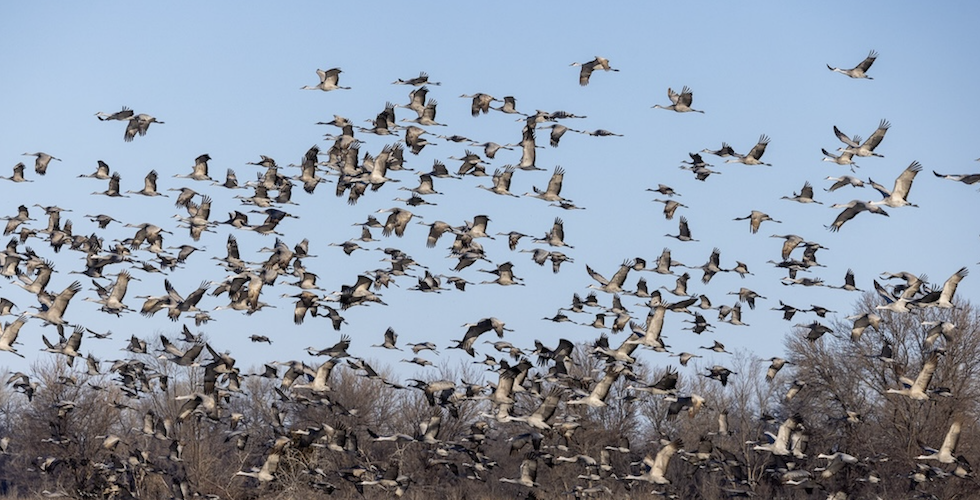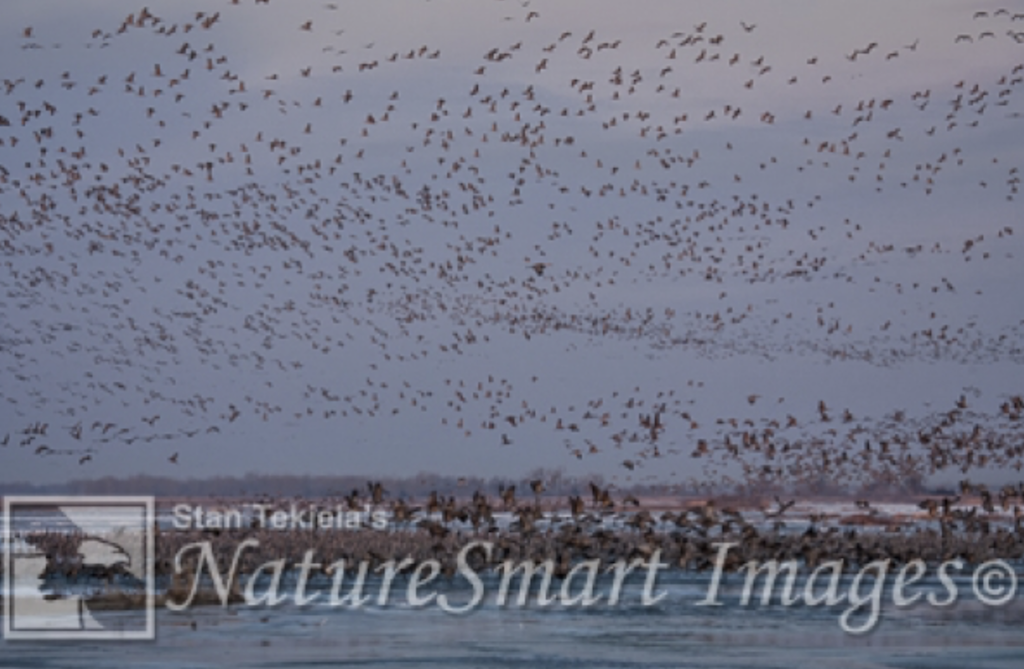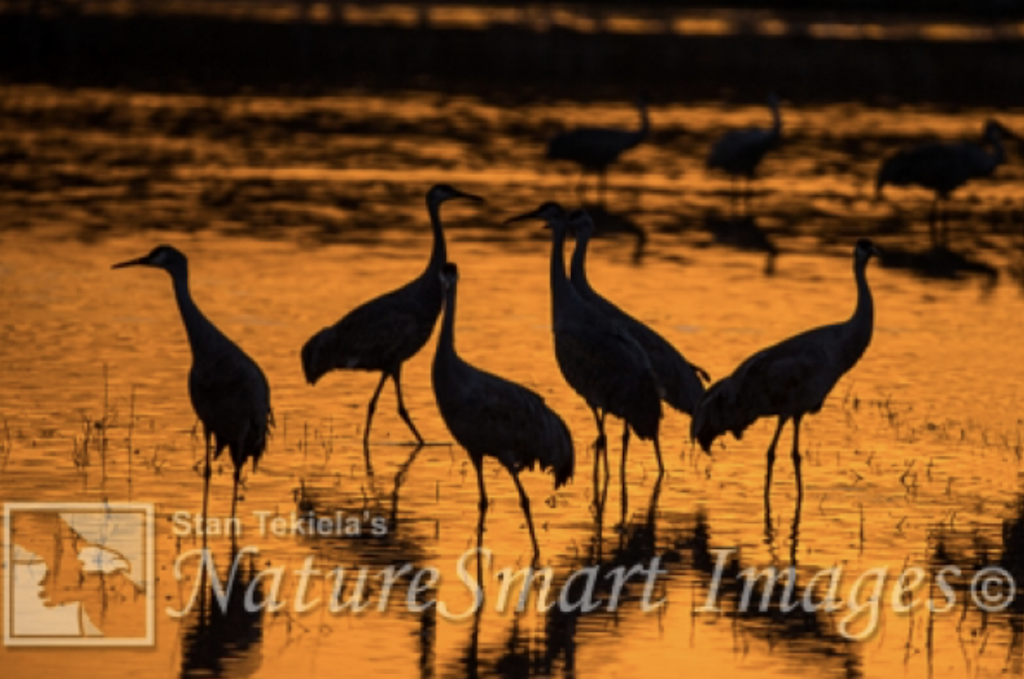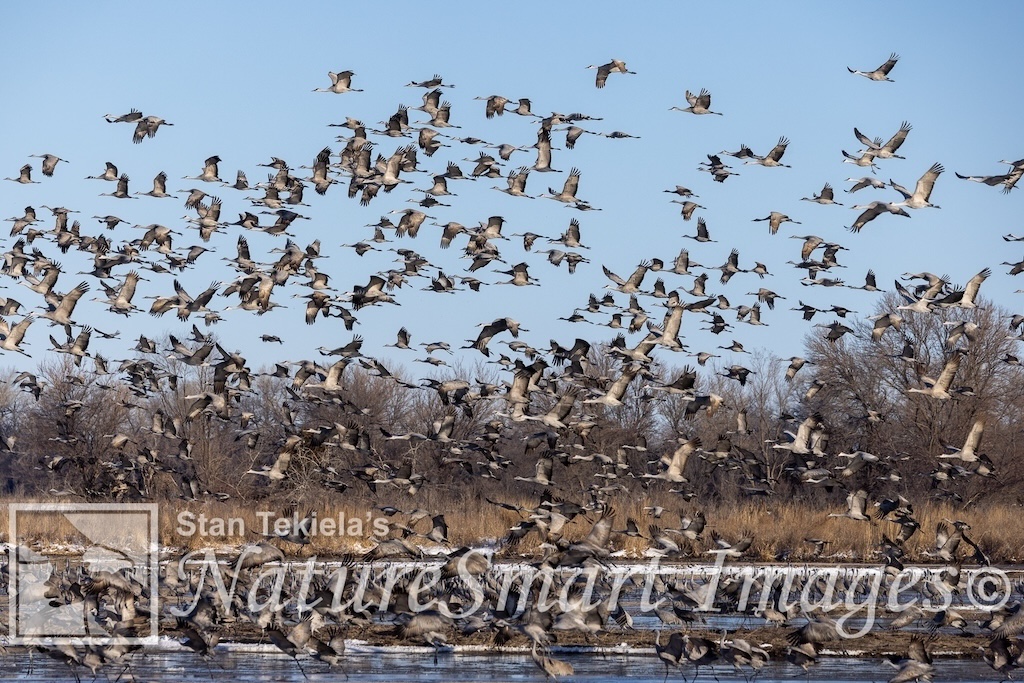
Stan Tekiela Reports on the Migration of the Sandhill Cranes
For more than 30 years, Stan Tekiela has led an annual trip to south-central Nebraska to observe the migration of the sandhill cranes. Here is his report on this year’s visit.
This year I had an incredible group of 10 that were so fun and just as excited to see the cranes as I was. The dynamics of a group can make or break a trip, and this one was perfect. It’s not easy getting up at 4 a.m. to go out in the cold and dark, so having an energetic group is always a good thing.

We made our way to south-central Nebraska, where hundreds of thousands of sandhill cranes gather on their northward springtime migration. A stretch of just 80 miles along the Platte River hosts upwards of half a million cranes each spring.
Upon our arrival, we had gray skies and high winds, but the agricultural fields near the Platte River had many flocks of sandhill cranes. It wasn’t unusual to see 500 or more cranes in just one location. Towards evening, the cranes started to move back towards the Platte River. This large river in southern Nebraska runs over 300 miles long before it terminates at the Missouri River. The Platte is a very shallow, meandering river with a sandy bottom and, most importantly, hundreds of small islands or sandbars that are perfect spots for the cranes to roost overnight.
After a hot dinner and a few drinks, we went to bed looking forward to watching the sunrise and seeing thousands of cranes. When my alarm went off at 3:45 a.m., I wasn’t happy about getting out of bed. But when I did, I looked out the window, and all I could see was snow. Not a good start. The 30 mph-plus wind was driving the snow horizontally, causing the roads to be shut down and stranding us in the hotel.

After breakfast, we ventured out into the snow-covered landscape to see how the cranes were doing and to find out what other birds we could see. It was a very productive morning! By noon, the snow had stopped; by 4 p.m., the skies on the western horizon started to clear. Temperatures were just above freezing, so the snow started to melt. We made our way over to the river at sunset to watch the cranes flying in from the surrounding areas to roost.
We had a wonderful sunset and saw thousands of cranes and a few hundred snow geese flying into the river. Watching this is always a spiritual experience.
For thousands of years, these sandhill cranes have been visiting the Platte River on their migration northward. There are no cranes that nest in Nebraska—they are just passing through. The sandhill cranes are some of the oldest birds in North America. Fossils of sandhills dating back 2.5 million years are common, and one crane fossil (a similar species of crane) found in Nebraska is estimated to be about 10 million years old. Either way you cut it, the cranes have been around a long, long time.

The next morning, my alarm went off again at 3:45 a.m., and this time the sky outside my window was clear. The wind had died down and was calm. From all my years of coming to see the crane migration, I knew it was going to be a great morning. We packed up and drove over to the blinds we had reserved. After a 15-minute walk in the dark, down a gravel pathway, we entered the wooden structure (blind) on the banks of the Platte River. Even though it was so dark and we couldn’t see anything, we could definitely hear thousands of cranes right out in front of us.
Slowly, as the sun rose in the eastern sky, we had enough light to see that approximately 10,000-plus cranes were standing in the shallow water of the Platte River right in front of us. The brighter it became, the louder the cranes became. Soon, groups of cranes (family units) started taking off from the river, heading out for the day to find food. Hundreds of cranes were flying at the same time. Often the entire flock takes off all at the same time in a thunderous and chaotic blast. But not this morning. It seemed they were going to fly off the river in a slow-but-steady pattern.
Over the next couple of hours, the cranes slowly peeled off from the roosting flock and headed out to feed. With thousands of cranes still in the river, our group was getting cold and hungry, so we left the blind and headed back. We had just experienced one of the most amazing and spectacular wildlife events in North America. It was so good to be back visiting my old friends, the sandhill cranes.
If you enjoyed Stan’s post, you might also like: Cranes, Herons & Egrets, Bird Migration: The Incredible Journeys of North American Birds, Wild Birds: North America’s Most Unique Birds, Bald Eagles: The Ultimate Raptors, Owls: The Majestic Hunters, Hummingbirds: Marvels of the Bird World, and, for little tykes, his series of Mamas & Babies board books.
For news on all our books, sign up for our newsletter. #bewellbeoutdoors



Annie Long
My mouth is hanging open and my arms are covered in goosebumps. Also, I’m weeping with joy and awe. Thank you, Stan.You write SO beautifully of this true miracle of life. I felt like I was there on the river with your group. After reading this, I will be looking at your other posts. Although this one will be hard to beat!
In sincere appreciation for one of the great experiences I’ve had this year–reading your true life adventure story.
Annie Long
Liliane Opsomer
I am so thrilled that Stan’s article gave you so much joy.